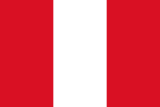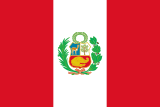Flag


Aflagis a piece offabric(most often rectangular) with a distinctive design and colours. It is used as asymbol,asignallingdevice, or for decoration. The termflagis also used to refer to thegraphic designemployed, and flags have evolved into a general tool for rudimentary signalling and identification, especially in environments where communication is challenging (such as themaritime environment,wheresemaphoreis used). Many flags fall into groups of similar designs calledflag families.[1]The study of flags is known as "vexillology"from theLatinvexillum,meaning "flag" or "banner".
National flagsarepatrioticsymbols with widely varied interpretations that often include strongmilitaryassociations because of their original and ongoing use for that purpose. Flags are also used inmessaging,advertising,or fordecorativepurposes.
Some military units are called "flags" after their use of flags. Aflag(Arabic:لواء) is equivalent to abrigadein Arab countries. In Spain, aflag(Spanish:bandera) is abattalion-equivalent in theSpanish Legion.[citation needed]
History
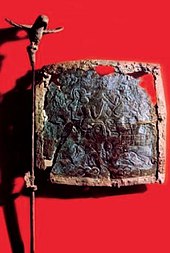
The origin of the flag is unknown[2]and it remains unclear when the first flag was raised.[3] Ships with vexilloids were represented on predynastic Egyptian potteryc. 3500 BC.[3]In antiquity,field signsthat can be categorised asvexilloidor "flag-like" were used in warfare, originating inancient EgyptorAssyria.[4]Examples include theSassanidbattle standardDerafsh Kaviani,and the standards of theRoman legionssuch as theeagleofAugustus Caesar'sXth legionand thedragon standardof theSarmatians;the latter was allowed to fly freely in the wind, carried by a horseman, but depictions suggest that it bore more similarity to an elongateddragon kitethan to a simple flag.
While the origin of the flag remains a mystery, the oldest flag discovered is made of bronze: aDerafshor 'flag-like' Shahdad, which was found inShahdad,Iran, and dates back toc. 2400 BC.It features a seated man and a kneeling woman facing each other, with a star in between. This iconography was found in other Iranian Bronze Age pieces of art.[5][6][7][8]
Flags made of cloth were almost certainly[4]the invention of the ancient peoples of theIndian subcontinentor theZhou dynastyofAncient China.Chinese flags had iconography such as a red bird, a white tiger, or a blue dragon, and royal flags were to be treated with a level of respect similar to that given to the ruler. Indian flags were often triangular and decorated with attachments such as ayak's tail and the state umbrella.[further explanation needed]Silk flags either spread to the Near East from China or it was just thesilkitself, later fashioned by people who had independently conceptualized a rectangular cloth attached to a pole.[9]Flags were probably transmitted to Europe via theMuslim world,where plainly coloured flags were used due toIslamic proscriptions.They are often mentioned in the early history of Islam and may have been copied from India.[4]
In Europe, during theHigh Middle Ages,flags came to be used primarily as aheraldic devicein battle, allowing easier identification of a knight over only the heraldic icon painted on the shield. Already during the high medieval period, and increasingly during theLate Middle Ages,city statesandcommunessuch as those of theOld Swiss Confederacyalso began to use flags as field signs. Regimental flags for individual units became commonplace during theEarly Modern period.

During the peak of thesailing age,beginning in the early 17th century, it was customary (and later a legal requirement) for ships to fly flags designating their nationality;[10]these flags eventually evolved into the national flags andmaritime flagsof today. Flags also became the preferred means ofcommunicationsat sea, resulting in various systems of flag signals;see,International maritime signal flags.
Use of flags beyond a military or naval context began with the rise ofnationalismby the end of the 18th century, although some flags date back earlier. The flags of countries such as Austria, Denmark or Turkey have legendary origins while many others, including those of Poland and Switzerland, grew out of the heraldic emblems of the Middle Ages. The 17th century saw the birth of severalnational flagsthrough revolutionary struggle. One of these was the flag of the Netherlands, which appeared during the80-year Dutch rebellionwhich began in 1568 against Spanish domination.[11]
Political change and social reform, allied with a growing sense of nationhood among ordinary people, led to the creation of new nations and flags all over the world in the 19th and 20th centuries.[12]
National flags
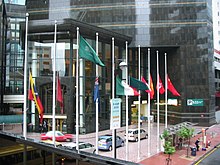

One of the most popular uses of a flag is to symbolise anationorcountry.Somenational flagshave been particularly inspirational to other nations, countries, or subnational entities in the design of their own flags. Some prominent examples include:
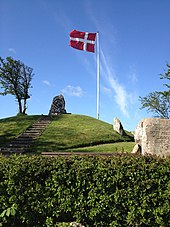
- Theflag of Denmark,theDannebrog,is attested in 1478, and is the oldest national flag still in use. It inspired thecross designof the otherNordic countries:Norway,Sweden,Iceland,Finland,and regional Scandinavian flags for theFaroe Islands,Åland,ScaniaandBornholm,as well as flags for the non-ScandinavianShetlandandOrkney.[13]
- Theflag of the Netherlandsis the oldesttricolour.Its three colours of red, white and blue go back toCharlemagne's time, the ninth century. The coastal region of what today is the Netherlands was then known for its cloth in these colours. Maps from the early 16th century already put flags in these colours next to this region, like Texeira's map of 1520. A century before that, during the 15th century, the three colours were mentioned as the coastal signals for this area, with the three bands straight or diagonal, single or doubled. Asstate flagit first appeared around 1572 as thePrince's Flagin orange–white–blue. Soon the more famous red–white–blue began appearing, becoming the prevalent version from around 1630. Orange made a comeback during the civil war of the late 18th century, signifying the orangist or pro-stadtholderparty. During World War II the pro-NaziNSBused it. Any symbolism has been added later to the three colours, although the orange comes from theHouse of Orange-Nassau.This use of orange comes from Nassau, which today uses orange-blue, not from Orange, which today uses red-blue. However, the usual way to show the link with the House of Orange-Nassau is the orange pennant above the red-white-blue. It is said that the Dutch Tricolour has inspired[14][citation needed]many flags but most notably those of Russia,New York City,andSouth Africa(the1928–94 flagas well the current flag). As the probable inspiration for theRussian flag,it is the source too for thepan-Slavic coloursred, white and blue, adopted by manySlavicstates and peoples as their symbols; examples areSlovakia,Serbia,andSlovenia.
- The nationalflag of Francewas designed in 1794. As a forerunner of revolution, France's tricolour flag style has been adopted by other nations. Examples:Italy,Belgium,Ireland,RomaniaandMexico.[citation needed]
- TheUnion Flag(Union Jack) of the United Kingdom is the most commonly used. British colonies typically flew a flag based on one of the ensigns based on this flag, and many former colonies have retained the design to acknowledge their cultural history. Examples:Australia,Fiji,New Zealand,Tuvalu,and also the Canadian provinces ofManitoba,OntarioandBritish Columbia,and the American state ofHawaii;seecommons:Flags based on British ensigns.
- Theflag of the United Statesis nicknamedThe Stars and StripesorOld Glory.[15]Some nations imitated this flag to symbolise their similarity to the United States or theAmerican Revolution.Examples:Liberia,[16]Chile,Taiwan (ROC),and the French region ofBrittany.
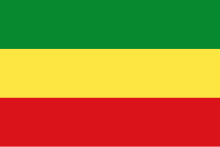
- Ethiopiawas seen as a model by emerging African states of the 1950s and 1960s, as it was one of the oldest independent states in Africa. Accordingly, itsflagbecame the source of thePan-African colours,or 'Rasta colours'. Examples:Benin,Togo,Senegal,Ghana,Mali,Guinea.
- Theflag of Turkey,which is very similar to the last flag of the oldOttoman Empire,has been an inspiration for the flag designs of many other Muslim nations. During the time of the Ottomans thecrescentbegan to be associated withIslamand this is reflected on the flags ofAlgeria,Azerbaijan,Comoros,Libya,Mauritania,Pakistan,TunisiaandMaldives.
- ThePan-Arab colours,green, white, red and black, are derived from the flag of theGreat Arab Revoltas seen on the flags ofJordan,Libya,Kuwait,Sudan,Syria,theUnited Arab Emirates,Western Sahara,Egypt,Iraq,YemenandPalestine.
- TheSoviet flag,with its golden symbols of thehammer and sickleon a red field, was an inspiration to flags of othercommuniststates, such asEast Germany,thePeople's Republic of China,Vietnam,Angola,Afghanistan (1978–1980)andMozambique.
- Theflag of Venezuela,created byFrancisco de Mirandato represent the independence movement in Venezuela that later gave birth to theGran Colombia,inspired the flags ofColombia,Ecuador,and theFederal Territories in Malaysia,all sharing three bands of yellow, blue and red with the flag of Venezuela.
- Theflag of Argentina,created byManuel Belgranoduring the war of independence, was the inspiration for theUnited Provinces of Central America's flag, which in turn was the origin for the flags ofGuatemala,Honduras,El Salvador,andNicaragua.
National flag designs are often used to signify nationality in other forms, such asflag patches.
Civil flags
Acivilflag is a version of the national flag that is flown by civilians on non-government installations or craft. The use of civil flags was more common in the past, in order to denote buildings or ships that were not crewed by the military. In some countries the civil flag is the same as thewar flagorstate flag,but without the coat of arms, such as in the case ofSpain,and in others it is an alteration of the war flag.
War flags

Several countries, including theRoyal Air Force,British Armyand theRoyal Navy(White Ensign) of theUnited Kingdomand theSoviet Unionhave hadunique flagsflown by theirarmed forcesseparately, rather than thenational flag.
Other countries' armed forces (such as those of the United States or Switzerland) use their standardnational flag;in addition, the U.S. has alongside flags and seals designed from long tradition for each of its six uniformed military services/military sub-departments in theDepartment of Defenseand theDepartment of Homeland Security.The Philippines' armed forces may use theirstandard national flag,but during times of war the flag is turned upside down.Bulgaria's flagis also turned upside down during times of war. These are also considered war flags, though the terminology only applies to the flag's military usage.
Large versions of the war flag flown on thewarshipsof countries'naviesare known asbattle ensigns.In addition, besides flying the national standard or a military services' emblem flag at a military fort, base, station or post and at sea at the stern (rear) or main top mast of a warship, aNaval Jack flagand othermaritime flags,pennantsand emblems are flown at the bow (front). In times of war waving a white flag is a banner of truce, talks/negotiations or surrender.
Four distinctive African flags currently in the collection of theNational Maritime MuseuminBritainwere flown in action byItsekiriships under the control ofNana Olomuduring the conflict in the late 19th century. One is the flag generally known as theBenin Empire flagand one is referred to as Nana Olomu's flag.[17]
International flags
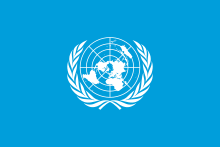
Among international flags are theUnited Nations,Europe,Olympic,NATOandParalympic flags.
Maritime flags
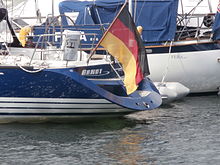
Flags are particularly important at sea, where they can mean the difference between life and death, and consequently where the rules and regulations for the flying of flags are strictly enforced. A national flag flown at sea is known as anensign.A courteous, peaceablemerchant shiporyachtcustomarily flies its ensign (in the usual ensign position), together with the flag of whatever nation it is currently visiting at the mast (known as acourtesy flag). To fly one's ensign alone in foreign waters, a foreign port or in the face of a foreign warship traditionally indicates a willingness to fight, withcannon,for the right to do so. As of 2009[update],this custom is still taken seriously by many naval and port authorities and is readily enforced in many parts of the world by boarding, confiscation and other civil penalties. In some countriesyacht ensignsare different from merchant ensigns in order to signal that the yacht is not carryingcargothat requires acustomsdeclaration. Carrying commercial cargo on a boat with a yacht ensign is deemed to besmugglingin many jurisdictions. Traditionally, a vessel flying under the courtesy flag of a specific nation, regardless of the vessel's country of registry, is considered to be operating under the law of her 'host' nation.

There is a system ofinternational maritime signal flagsfor numerals and letters of the alphabet. Each flag or pennant has a specific meaning when flown individually. As well,semaphore flagscan be used to communicate on anad hocbasis from ship to ship over short distances.
Another category of maritime flag flown by someUnited States governmentships is thedistinctive mark.Although theUnited States Coast Guardhas its own service ensign, all other U.S. government ships fly the national ensign as their service ensign, followingUnited States Navypractice. To distinguish themselves from ships of the Navy, such ships historically have flown their parent organisation's flag from a forward mast as a distinctive mark. Today, for example, commissioned ships of theNational Oceanic and Atmospheric Administration(NOAA) fly theNOAA flagas a distinctive mark.
Shapes and designs



Flags are usually rectangular in shape (often in the ratio 2:3, 1:2, or 3:5), but may be of any shape or size that is practical for flying, including square, triangular, or swallow tailed. A more unusual flag shape is that of theflag of Nepal,which is in the shape of two stacked triangles. Other unusually shaped flags include the civil flags ofOhio(aswallowtail);Tampa, Florida;andPike County, Ohio.[18]
Many flags are dyedthrough and throughto be inexpensive to manufacture, such that the reverse side is themirror imageof theobverse(front) side, generally the side displayed when, from the observer's point of view, the flag flies from pole-side left to right. This presents two possibilities:
- If the design issymmetricalin an axis parallel to the flag pole, obverse and reverse will be identical despite the mirror-reversal, such as theIndian FlagorCanadian Flag
- If not, the obverse and reverse will present two variants of the same design, one with thehoiston the left (usually considered the obverse side), the other with the hoist on the right (usually considered the reverse side of the flag). This is very common and usually not disturbing if there is no text in the design.
Some complex flag designs are not intended to be shown on both sides, requiring separate obverse and reverse sides if made correctly. In these cases there is a design element (usually text) which is not symmetric and should be read in the same direction, regardless of whether the hoist is to the viewer's left or right. These cases can be divided into two types:
- The same (asymmetric) design may be duplicated on both sides. Such flags can be manufactured by creating two identical through and through flags and then sewing them back to back, though this can affect the resulting combination's responsiveness to the wind. Depictions of such flags may be marked with the symbol
 ,indicating the reverse is congruent to (rather than a mirror image of) the obverse.
,indicating the reverse is congruent to (rather than a mirror image of) the obverse. - Rarely, the reverse design may differ, in whole or in part, from that of the obverse. Examples offlags whose reverse differs from the obverseinclude theflag of Paraguay,theflag of Oregon,and the historicalflag of the Soviet Union.Depictions of such flags may be marked with the symbol
 .
.

Common designs on flags include crosses, stripes, and divisions of the surface, orfield,into bands or quarters—patterns and principles mainly derived fromheraldry.A heraldic coat of arms may also be flown as abanner of arms,as is done on both the stateflag of Marylandand theflag of Kiribati.
Thede jureflag of LibyaunderMuammar Gaddafi,which consisted of a rectangular field of green, was for a long period the only national flag using a single colour and no design or insignia. However, other historical states have also used flags without designs or insignia, such as the short-livedSoviet Republic of Hungaryand the more recentSultanate of Muscat and Oman,whose flags were both a plain field of red.
Colours are normally described with common names, such as "red", but may be further specified usingcolourimetry.
The largest flag flown from a flagpole worldwide, according to Guinness World Records, is theflag of the United Arab Emiratesflown inSharjah.This flag was 2,448.56 m2(26,356.1 sq ft).[19]The largest flag ever made was theflag of Qatar;the flag, which measures at 101,978 m2(1,097,680 sq ft), was completed in December 2013 inDoha.[20]
Parts of a flag
The general parts of a flag are: canton (the upper inner section of the flag), field or ground (the entire flag except the canton), the hoist (the edge used to attach the flag to the hoist), and the fly (the furthest edge from the hoist end).[21]
Vertical flags
Vertical flags are sometimes used in lieu of the standard horizontal flag in central and eastern Europe, particularly in the German-speaking countries. This practice came about because the relatively brisk wind needed to display horizontal flags is not common in these countries.[22]

The standardhorizontal flag(no. 1 in the preceding illustration) is nonetheless the form most often used even in these countries.[23]

Thevertical flag(German:HochformatflaggeorKnatterflagge;no. 2) is a vertical form of the standard flag. The flag's design may remain unchanged (No. 2a) or it may change, e.g. by changing horizontal stripes to vertical ones (no. 2b). If the flag carries an emblem, it may remain centred or may be shifted slightly upwards.[22][24]
Thevertical flag for hoisting from a beam(German:AuslegerflaggeorGalgenflagge;no. 3) is additionally attached to a horizontal beam, ensuring that it is fully displayed even if there is no wind.[22][25]
Thevertical flag for hoisting from a horizontal pole(German:Hängeflagge;no. 4) is hoisted from a horizontal pole, normally attached to a building. The topmost stripe on the horizontal version of the flag faces away from the building.[22][26]
Thevertical flag for hoisting from a crossbarorbanner(German:Bannerflagge;no. 5) is firmly attached to a horizontal crossbar from which it is hoisted, either by a vertical pole (no. 5a) or a horizontal one (no. 5b). The topmost stripe on the horizontal version of the flag normally faces to the left.[22][27]
Religious flags
Flags can play many different roles in religion. InBuddhism,prayer flagsare used, usually in sets of five differently coloured flags. Several flags and banners including theBlack Standardareassociated with Islam.Manynational flagsand other flags include religious symbols such as the cross, the crescent, or a reference to a patron saint. Flags are also adopted by religious groups and flags such as theJain flag,Nishan Sahib(Sikhism), theSaffron flag(Hindu) and theChristian flagare used to represent a whole religion.
-
Poland (Gorzów Wlkp.). Religious flags
-
Christian flagadopted by severalProtestantdenominations
-
Jain flag(on occasion, the bottom black bar is replaced with a dark blue one)
-
Nishan Sahib(theSikhflag)
In sports
Because of their ease of signalling and identification, flags are often used insports.
- Inassociation football,linesmencarry small flags along the touch lines. They use the flags to indicate to therefereepotential infringements of the laws, or who is entitled to possession of the ball that has gone out of the field of play, or, most famously, raising the flag to indicate anoffsideoffence. Officials calledtouch judgesuse flags for similar purposes in both codes ofrugby.
- InAmericanandCanadian football,refereesusepenalty flagsto indicate that a foul has been committed in game play. The phrase used for such an indication isflag on the play.The flag itself is a small, weighted handkerchief, tossed on the field at the approximate point of the infraction; the intent is usually to sort out the details after the current play from scrimmage has concluded. In American football, the flag is yellow; in Canadian football the flag is orange, but at the professional level the flag is yellow. In both theCanadian Football LeagueandNational Football League,coaches also use red challenge flags to indicate that they wish to contest a ruling on the field.
- Inyacht racing,flags are used to communicate information from the race committee boat to the racers. Different flags hoisted from the committee boat may communicate a false start, changes in the course, a cancelled race, or other important information. Racing boats themselves may also use flags to symbolise a protest or distress. The flags are often part of the nautical alphabetic system ofInternational maritime signal flags,in which 26 different flags designate the 26 letters of the Latin alphabet.

- Inautoandmotorcycle racing,racing flagsare used to communicate with drivers. Most famously, a checkered flag of black and white squares indicates the end of the race, and victory for the leader. A yellow flag is used to indicate caution requiring slow speed and a red flag requires racers to stop immediately. A black flag is used to indicate penalties.
- In addition, fans of almost all sports wave flags in the stands to indicate their support for the participants. Many sports teams have their own flags, and, in individual sports, fans will indicate their support for a player by waving the flag of his or her home country.
- Capture the flagis a popular children's sport.
- InGaelic footballandHurlinga green flag is used to indicate a goal while a white flag is used to indicate a point
- InAustralian rules football,thegoal umpirewill wave two flags to indicate a goal (worth six points) and a single flag to indicate a behind (worth one point).
- For safety,dive flagsindicate the locations of underwaterscuba diversor that diving operations are being conducted in the vicinity.
- In water sports such as wakeboarding and Water-Skiing, an orange flag is held in between runs to indicate someone is in the water.
- Ingolf,the hole is almost always marked with a flag. The flagpole is designed to fit centered within the base of the hole and is removable. Many courses will use colour-coded flags to determine a hole location at the front, middle or rear of the green. However, colour-coded flags are not used in the professional tours. (A rare example of a golf course that does not use flags to mark the hole is the East Course ofMerion Golf Club,which instead uses flagpoles topped bywicker baskets.)
- Flag poles with flags of all shapes and sizes are used by marching bands, drum corps, and winter guard teams use flags as a method of visual enhancement in performances.
Diplomatic flags
Some countries use diplomatic flags, such as the United Kingdom (seeimage of the Embassy flag) and the Kingdom ofThailand(seeimage of the Embassy flag).
Thesocialistmovement usesred flagsto represent their cause. Theanarchistmovement has a variety of different flags, but the primary flag associated with them is theblack flag.In theSpanish Civil War,the anarchists used the red-and-black bisected flag. In the 20th century, therainbow flagwas adopted as a symbol of theLGBT social movements.Its derivatives include theBisexual prideandTransgender pride flags.
Some of these political flags have become national flags, such as the red flag of theSoviet Unionand national socialist banners forNazi Germany.The presentFlag of Portugalis based on what had been the political flag of thePortuguese Republican Partyprevious to the5 October 1910 revolutionwhich brought this party to power.
Personal flags

Throughout history,monarchshave often had personal flags (includingroyal standards), representing the royal person, including inpersonal unionof national monarchies.
Vehicle flags
Flags are often representative of an individual's affinity or allegiance to a country, team or business and can be presented in various ways. A popular trend that has surfaced revolves around the idea of the 'mobile' flag in which an individual displays their particular flag of choice on their vehicle. These items are commonly referred to as car flags and are usually manufactured from high strength polyester material and are attached to a vehicle via a polypropylene pole and clip window attachment.
Swimming flags


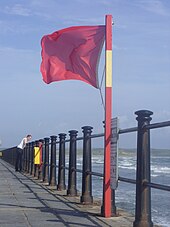
In Australia, Canada, New Zealand, the Philippines, Ireland and the United Kingdom, a pair of red-yellow flags is used to mark the limits of the bathing area on a beach, usually guarded bysurf lifesavers.If the beach is closed, the poles of the flags are crossed. The flags are coloured with a red triangle and a yellow triangle making a rectangular flag, or a red rectangle over a yellow rectangle. On many Australian beaches there is a slight variation with beach condition signalling. A red flag signifies a closed beach (in the UK also other dangers), yellow signifies strong current or difficult swimming conditions, and green represents a beach safe for general swimming. In Ireland, a red and yellow flag indicates that it is safe to swim; a red flag that it is unsafe; and no flag indicates that there are no lifeguards on duty. Blue flags may also be used away from the yellow-red lifesaver area to designate a zone for surfboarding and other small, non-motorised watercraft.
Reasons for closing the beach include:
- dangerous rip
- hurricanewarning
- nolifeguardsin attendance
- overpollutedwater
- sharks
- tsunami
- wavestoo strong
A surf flag exists, divided into four quadrants. The top left and bottom right quadrants are black, and the remaining area is white.
Signal flag"India" (a black circle on a yellow square) is frequently used to denote a "blackball" zone where surfboards cannot be used but other water activities are permitted.
Railway flags
Railways use a number of coloured flags. When used as wayside signals they usually use the following meanings (exact meanings are set by the individual railroad company):
- red = stop
- yellow = proceed with caution
- green or white = proceed.
- a flag of any colour waved vigorously means stop
- a blue flag on the side of a locomotive means that it should not be moved because someone is working on it (or on the train attached to it). A blue flag on a track means that nothing on that track should be moved. The flag can only be removed by the person or group that placed it. In the railway dominated steel industry this principle of "blue flag and tag" was extended to all operations at Bethlehem Steel,Lackawanna, New York.If a man went inside a large machine or worked on an electrical circuit for example, his blue flag and tag was sacrosanct.[28]The "Lock Out/Tag Out"practice is similar and now used in other industries to comply with safety regulations.
At night, the flags are replaced with lanterns showing the same colours.
Flags displayed on the front of a moving locomotive are an acceptable replacement for classification lights and usually have the following meanings (exact meanings are set by the individual railroad company):
- white = extra (not on the timetable)
- green = another section following
- red = last section
Additionally, a railroad brakeman will typically carry a red flag to make his or her hand signals more visible to the engineer.Railway signalsare a development of railway flags.[29]
Flagpoles
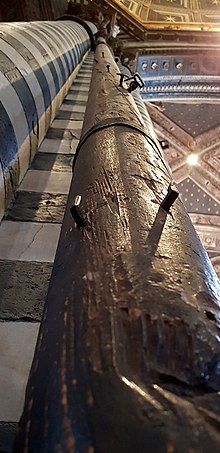
A flagpole, flagmast, flagstaff, or staff can be a simple support made of wood or metal. If it is taller than can be easily reached to raise the flag, a cord is used, looping around a pulley at the top of the pole with the ends tied at the bottom. The flag is fixed to one lower end of the cord, and is then raised by pulling on the other end. The cord is then tightened and tied to the pole at the bottom. The pole is usually topped by a flat plate or ball called a "truck"(originally meant to keep a wooden pole from splitting) or afinialin a more complex shape. Very high flagpoles may require more complex support structures than a simple pole, such as aguyed mast.
Dwajasthambamare flagpoles commonly found at the entrances ofSouth IndianHindu temples.[30]
Record heights

Since 26 December 2021, thetallest free-standing flagpolein the world is the Cairo Flagpole, located in theNew Administrative Capitalunder construction inEgyptat a height of 201.952 m (662.57 ft), exceeding the former record holders, theJeddah FlagpoleinSaudi Arabia(height: 171 m; 561 ft), theDushanbe FlagpoleinTajikistan[31][32](height: 165 m; 541 ft) and theNational FlagpoleinAzerbaijan(height: 162 m; 531 ft).[33]The flagpole in North Korea is the fourth tallest flagpole in the world, however, it is not free-standing. It is a radio tower supported flagpole. Many of these were built by American company Trident Support: the Dushanbe Flagpole, the National Flagpole in Azerbaijan, theAshgabat flagpolein Turkmenistan at 133 m (436 ft); theAqaba Flagpolein Jordan at 130 m (430 ft); theRaghadan Flagpolein Jordan at 126.8 m (416 ft); and the Abu Dhabi Flagpole in the United Arab Emirates at 122 m (400 ft).[34]
The current tallest flagpole in India (and the tallest flying the tricolour) is the 110-metre (360 ft) flagpole inBelgaum,Karnataka which was first hoisted on 12 March 2018.[35][36]The tallest flagpole in the United Kingdom from 1959 until 2013 stood inKew Gardens.It was made from a Canadian Douglas-fir tree and was 68.5 m (225 ft) in height.[37]
The current tallest flagpole in the United States (and the tallest flying an American flag) is the 400-foot (120 m) pole completed beforeMemorial Day2014 and custom-made with an 11-foot (3.4 m) base in concrete bywind turbinemanufacturer Broadwind Energy. It is situated on the north side of theAcuity Insuranceheadquarters campus alongInterstate 43inSheboygan, Wisconsin,and is visible fromCedar Grove.The pole can fly a 220-pound flag in light wind conditions and a heavier 350-pound flag in higher wind conditions.[38]
Design
Flagpoles can be designed in one piece with a taper (typically a steel taper or aGreek entasistaper),[39]or be made from multiple pieces to make them able to expand. In the United States,ANSI/NAAMMguide specification FP-1001-97 covers the engineering design of metal flagpoles to ensure safety.
-
Flagpole of modest size, with simpletruck
-
Large flagpole, showing structuredtruck(New Zealand)
-
New Caledoniahas two flags, flown here inNouméa,the capital city, on a single flagpole with a crossbar
Hoisting the flag

Hoisting the flag is the act of raising the flag on the flagpole. Raising or lowering flags, especially national flags, usually involves ceremonies and certain sets of rules, depending on the country, and usually involve the performance of anational anthem.
A flag-raising squad is a group of people, usually troops, cadets, or students, that march in and bring the flags for the flag-hoisting ceremony. Flag-hoisting ceremonies involving flag-raising squads can be simple or elaborate, involving large numbers of squads. Elaborate flag-hoisting ceremonies are usually performed on national holidays.
The cord or rope that ties a flag to its pole is called a halyard. Flags may have a strip of fabric along the hoist side called aheadingfor the halyard to pass through, or a pair ofgrommetsfor the halyard to be threaded through. Flags may also be held in position usingInglefield clips.[40]
Flags in communication

Semaphoreis a form of communication that utilises flags. The signalling is performed by an individual using two flags (or lighted wands), the positions of the flags indicating a symbol. The person who holds the flags is known as the signalman. This form of communication is primarily used bynavalsignallers. This technique of signalling was adopted in the early 19th century and is still used in various forms today.[41]
The colours of the flags can also be used to communicate. For example; a white flag means, among other things, surrender or peace, a red flag can be used as a warning signal, and a black flag can mean war, or determination to defeat enemies.
Orientation of a flag is also used for communication, though the practice is rarely used given modern communication systems. Raising a flag upside-down was indicative that the raising force controlled that particular area, but that it was in severe distress.[42]
See also
- Lists and galleries of flags
- Notable flag-related topics
- Flag families
- False flag
- Flag Day
- Flag desecration
- Flag protocol
- Flag patch
- Flag semaphore
- Flag throwing
- Glossary of vexillology
- Pledge of Allegiance (United States)
- Standard-bearer(also enumerates various types of standards, both flag types and immobile ensigns)
- Vexillology
- Flags of the World,an Internet-based vexillological association and resource
- Windsock
Citations
- ^Znamierowski, Alfred (2013).The World Encyclopedia of Flags: The Definitive Guide to International Flags, Banners, Standards and Ensigns, with Over 1400 Illustration.Lorenz Books. pp. 100–129.ISBN978-0-7548-2629-3.
- ^Inglefield, p. 39.
- ^abSmith, Whitney (1975).Flags through the ages and across the world.Internet Archive. New York. p. 33.ISBN978-0-07-059093-9.
- ^abcFlag | heraldry.Encyclopedia Britannica.Retrieved February 15, 2019.
- ^Graef, Katrien De; Tavernier, Jan (7 December 2012).Susa and Elam. Archaeological, Philological, Historical and Geographical Perspectives.: Proceedings of the International Congress Held at Ghent University, December 14–17, 2009.BRILL.ISBN978-9004207400– via Google Books.
- ^Pittman, Holly; N.Y.), Metropolitan Museum of Art (New York (12 December 1984).Art of the Bronze Age: Southeastern Iran, Western Central Asia, and the Indus Valley.Metropolitan Museum of Art.ISBN9780870993657– via Google Books.
- ^Hansen, Donald P.; Ehrenberg, Erica (12 December 2017).Leaving No Stones Unturned: Essays on the Ancient Near East and Egypt in Honor of Donald P. Hansen.Eisenbrauns.ISBN9781575060552– via Google Books.
- ^Hakemi, Ali; Archeologiche, Istituto italiano per il Medio ed Estremo Oriente Centro Scavi e Ricerche (12 December 1997).Shahdad: archaeological excavations of a bronze age center in Iran.IsMEO.ISBN9788120410176– via Google Books.
- ^Smith, Whitney (1975).Flags through the ages and across the world.Internet Archive. New York. p. 41.ISBN978-0-07-059093-9.
- ^Articles 90–94 of theUN Convention on the Law of the Sea
- ^Inglefield, p. 48.
- ^Inglefield, p. 50.
- ^National Flag -The official website of DenmarkArchived2018-02-03 at theWayback Machine.Earlier use of the white cross on red is attested by an armorial (Netherlands) of 1370-1386. In later monastic tradition, the Dannebrog made its first, miraculous appearance at the Battle of Lindanise on 15 June 1219.
- ^Smith, Whitney."flag of France | History & Meaning".Encyclopedia Britannica.Retrieved2019-02-24.
- ^Smith, Whitney."Flag of the United States of America".Encyclopedia Britannica.Retrieved2019-05-24.
- ^Smith, Whitney."Flag of Liberia".Encyclopedia Britannica.Retrieved2019-05-24.
- ^"Welcome to the Royal Museums Greenwich Blogs - Royal Museums Greenwich Blogs"(PDF).Archived fromthe original(PDF)on 2011-09-28.Retrieved2010-05-24.
- ^"Pike".County Flags.Columbus, Ohio:Ohio StatehouseMuseum.RetrievedJuly 20,2019.
- ^"Largest flag flown".28 March 2022.
- ^"Qatar breaks record for world's largest flag".BBC. December 17, 2013.RetrievedDecember 17,2013.
- ^"The Parts of a Flag".Flag Terminology.NSTATE.Retrieved2019-08-02.
- ^abcde"Flaggentypen".German Vexillological Society (Deutsche Gesellschaft für Flaggenkunde e. V., DGF).Retrieved20 February2012.
- ^German Federal Ministry of the Interior:HissflaggeArchived2012-09-08 atarchive.today,accessed 20 February 2012
- ^German Federal Ministry of the Interior:HochformatflaggeArchived2012-08-03 at theWayback Machine,accessed 20 February 2012
- ^German Federal Ministry of the Interior:AuslegerflaggeArchived2012-08-03 at theWayback Machine,accessed 20 February 2012
- ^German Federal Ministry of the Interior:HängeflaggeArchived2012-08-03 at theWayback Machine,accessed 20 February 2012
- ^German Federal Ministry of the Interior:HängeflaggeArchived2012-08-03 at theWayback Machine,accessed 20 February 2012
- ^"Docket No. 79-2597".Archived fromthe originalon 2010-05-27.Retrieved2010-06-27.
- ^Calvert, J.B. (25 July 2004)."Early Railway Signals".University of Denver.Retrieved7 October2007.
- ^Hiltebeitel, Alf(1991).The Cult of Draupadi, Volume 2: On Hindu Ritual and the Goddess.University of Chicago Press.ISBN0226340473.pp. 91–92.
- ^"Jeddah Flagpole inaugurated".arabnews.com.Retrieved2014-09-23.
- ^Former record:"Wer baut den hoechsten Fahnenmast".Asia Plus. September 9, 2008. Archived fromthe originalon April 4, 2019.RetrievedMay 24,2011.
- ^"Flag of Azerbaijan".Telegraph.co.uk. July 3, 2008.Archivedfrom the original on 2022-01-11.
- ^"Looking for Afghanistan? Turn Left at the Enormous Flagpole".National Geographic.2017-09-05.
- ^"Karnataka's Belgaum is now home to India's tallest flag".Times Now News.13 March 2018.Retrieved6 July2019.
- ^"Tallest flag in India: Country's tallest tricolour to be hoisted in Belagavi".The Times of India.Mar 12, 2018.Retrieved6 July2019.
- ^"Timber! Steeplejacks to dismantle Kew Flagpole".Kew.org. Archived fromthe originalon 2016-08-17.
- ^Weyandt, Janet (25 May 2014)."High-flying: Up in time for Memorial Day, Acuity flag is world's tallest".The Sheboygan Press.Archived fromthe originalon 3 April 2015.Retrieved26 May2014.
- ^"Cone Tapered vs. Venetian Entasis Tapered".Lingo Flagpoles Inc. Archived fromthe originalon 2005-02-28.
- ^Inglefield, p. 12.
- ^"Semaphore Flag Signalling System".ANBG.gov.au.Retrieved31 March2017.
- ^Scanlon, Caitlin."Flag Etiquette Do's and Don'ts".Military.com.Retrieved2017-10-05.
General and cited references
- Inglefield, Eric (1979 edition).Flags.Ward Lock, London.ISBN0706356527
External links
 flag (P163)(seeuses)
flag (P163)(seeuses)

